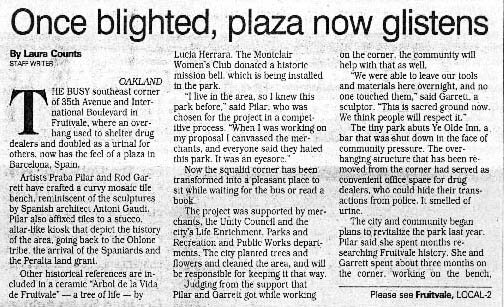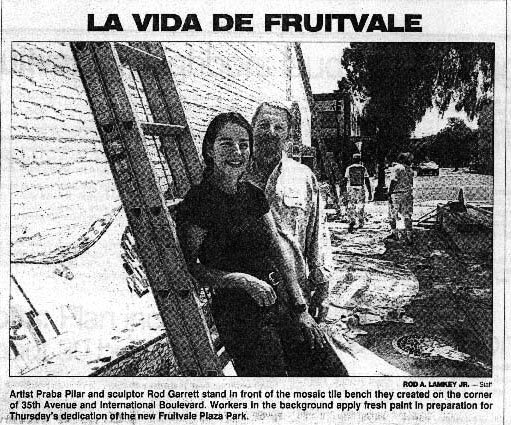Fruitvale Plaza Park
In March of 1998, the community in Fruitvale and several agencies joined forces to revitalize a pocket part at 35th Street and International Boulevard in Fruitvale, Oakland. The City of Oakland and the Spanish Speaking Unity Council circulated a call for proposals for public art to redesign this park. The call asked for a kiosk for community information to be installed. After extensive analysis, Praba Pilar proposed an entire revamp that would include demolition, and building a new bench and other works while including elements that were already in the park. The plan was to turn the site into a community plaza where neighbors could come, have a seat under the tree or on a bench, and take a minute.
Site view on completion of project, July 1999.
Site view before construction at 35th and International Boulevard, Fruitvale, Oakland. March, 1998.
Inspired by Spanish architect Gaudi, Pilar’s design proposal included a mosaic tile bench, a serpentine floor piece, and an information kiosk for community announcements. Upon being granted the project, Praba Pilar invited Oakland sculptor Rod Garrett, who had a general contractor license, to collaborate on all aspects of building and developing the site and creating the mosaic tile pieces. Pilar’s "Open Plan" proposal began by addressing issues of pedestrian flow through the site. Obstructive elements were demolished to improve the pedestrian flow throughout the park and introduce a new seating area. The plan introduced the history of the area through a new community kiosk with historic tiles of Fruitvale from the turn of the century through today. These include the images of the Ohlone, the Spanish land grant to Vincent Peralta, and subsequent fruit orchards, ranchos and farms from which the area derives its name. The plan memorialized Sausal Creek through a mosaic tile floor piece. This creek, along with others in the area now runs invisibly through culverts underground.
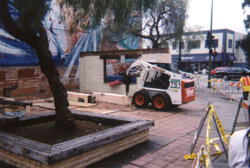
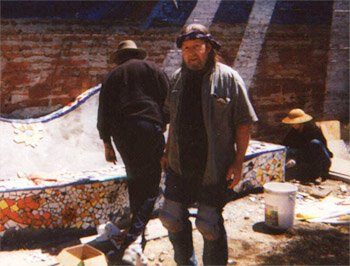
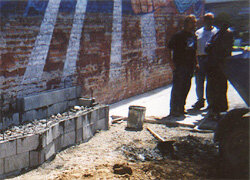
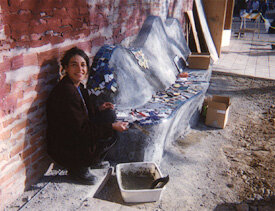
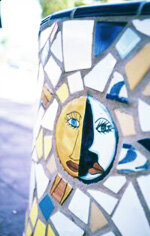
Site work began in April, 1999 with the demolition of structures blocking pedestrian flow in the park. The mosaic tile bench was begun, with donated materials and the help of project volunteers. The free form curving cement understructure was built insinuating the creeks which run through pipes underground through the area. Mosaic tile installation took two months of on-site work by Rod and Praba, with help from volunteers and lots of resident input.
A new planter was built to bring more greenery into the park, and Team Oakland committed to providing the dirt and plants for the park and to do maintenance. The serpentine creek form was stamped into the concrete, and the mosaic tile representation of our geographic history installed.
Oakland History Room librarians helped procure images of Fruitvale from 1820 through today for the community kiosk. Mica Messenheimer assisted with phototransfers of these images onto tile.
The project was inaugurated on July 15, 1999, with a 15 piece Mariachi band and food for 200 people. Originally, the City of Oakland was going to police the area and prevent homeless and low income residents from attending the inaugural. After negotiations with artists Praba Pilar and Rod Garrett demanding that no police be on site and all homeless folks be welcome, these restrictions were lifted. Many community members attended, ate delicious food, danced to the mariachis, alongside Oakland City Council President Ignacio de la Fuente, Oakland Mayor Jerry Brown and Oakland Parks and Recreation Interim Director Antonio Acosta.
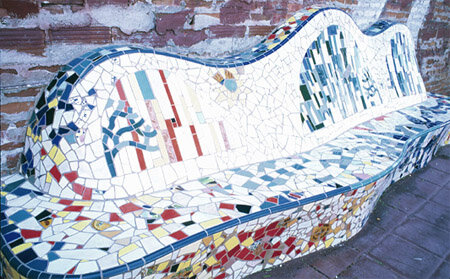
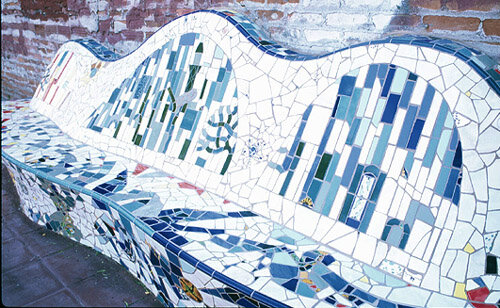
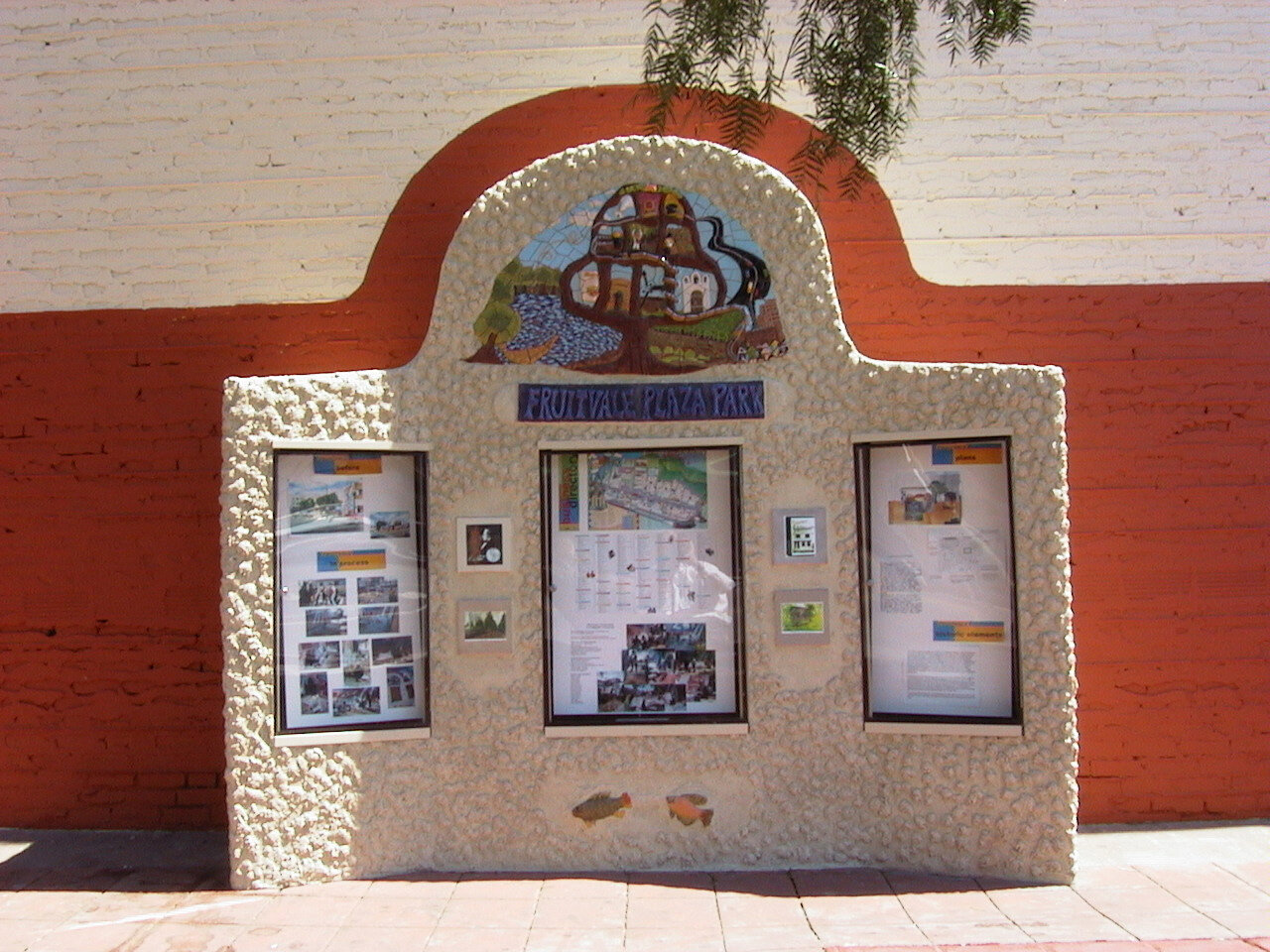
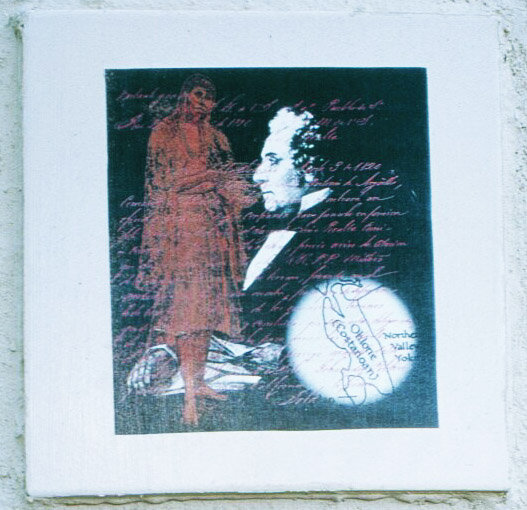
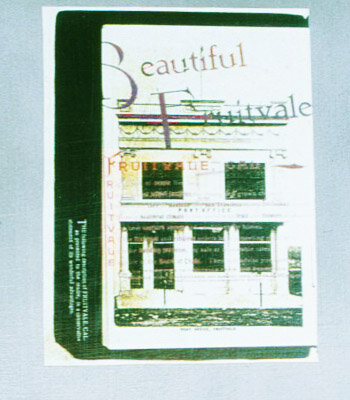
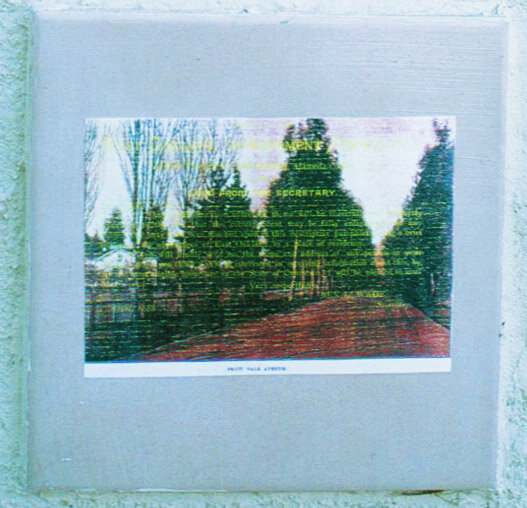
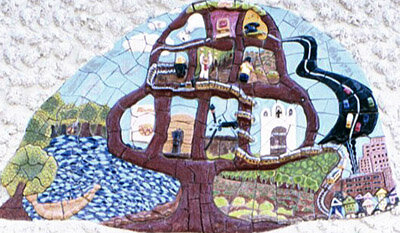

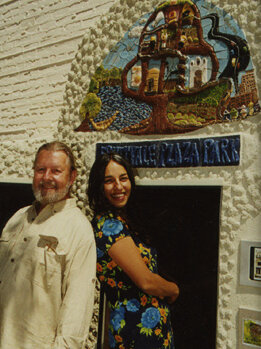

Ceramic artist Lucia Herrera was commissioned to do an original ceramic piece honoring the different historical periods of the area. She created an "Arbol de la Vida de Fruitvale," or "Tree of life of Fruitvale." This piece begins on the lower left showing Sausal Creek and a canoe of the Ohlone people, original and present day inhabitants of the area. The creek banks are covered with trees, as before colonization the area of Fruitvale was filled with redwood trees. In the 1840's the logging of the magnificent East Bay old growth forests began and within ten years was complete.
The bottom panel of the tree reflects the colonization of the area by the Spanish Crown, and the land grant of the entire area by the Spanish Crown to Vincent Peralta in 1820. It has images from the Ohlone Way book of an Ohlone man building shelter, the guns of the Spaniards and the church, and Spanish occupation, an era of ranchos and moderate settlement.
In the mid-1800's, a farming community developed in the area and brought in Californios, Germans and Portugese immigrants. For a time Fruitvale was a German-speaking community of dairy farms and fruit orchards. In 1865 the railroad, which snakes around the base of the tree, was extended into Fruitvale, bringing in workers to build the railroad and more residents and industry to the area.
By the early 1920's, a lively commercial strip developed along East 14th and Fruitvale came to be known as Oakland's "Second City". With the decline of farming and the rise of canneries, foundries and steel works, the area took on more of a working class character. World War II brought an influx of people and immigrants from Central America and Asia.
Today, Fruitvale reflects the diverse history of the area. As Oakland historian Betty Marvin says: "The layers left by a century of development are there to be read in the buildings, the street patterns, the multi-lingual names, and the unique businesses."
Left on the site by a neighborhood resident....
Park Poem
In a place where the color of life
and the sounds of people prevail
These artist's creation a story tells
Of history how it was back when
The land was the people's very best friend.
The local people hard working gentry
A place where Jack London
once made memories
Two artists came with a vision of splendor
In hopes their creation soon wood render
Thoughts of love and of unity
In this multicultural community
Their vision grew from pieces of tile
Wire and plaster, and all the while
People watched and they admired
Two artists possibly divinely inspired
This artistic creation brought curious notions
From all kinds of folk from across various oceans.
Together in the Fruitvale neighborhood
People smiled and they understood
The beauty expressed in this form of art
Of our neighborhood, now a meaningful part
So our two artistic visionary's
The message they leave hopefully carries
an expression of love, hope and peace
For the folks who adorn the neighborhood streets
Not just a message of tiles and stone
A part of our neighborhood, our life, our home
Thanks, Steven Squaglin, Tree Man
This project was voted favorite landmark in the area in an East Bay Express poll, was awarded the 1999 Historic Preservation Award of the Oakland Heritage Alliance, and was featured in local media and in the February/March 2000 issue of Ms. Magazine.
Interesting things about the process of this project: Installing this project is one of the funnest things Rod or I had ever done. We completed the on site installation in two months, working from about 7am to 12pm, taking a break to get out of the sun, then from 2pm - 6pm. So many people engaged, spoke to us, added tile, brought us food, chatted with each other, offered help, and chipped in. It was a beautiful community experience. After the inaugural and for two weeks, whenever I was in the neighborhood, people would ask me for my autograph. This passed very quickly. On another note, artists have leeway with local authority. The City of Oakland building department demanded we put barriers on the bench so no one could lay down on it. We were purposely providing a place to lay down, for anyone that needed it. We won that one by invoking artistic license. This process took about 16 months end to end, and I was not paid the bulk of the money until the very end. This was so costly and difficult to manage financially that I was not able to do anymore public art.
"Once blighted, plaza now glistens," by Laura Counts. The Oakland Tribune, July 14, 1999, Cityside Pg. 1
CREDITS
Praba Pilar, Lead Artist and Sculptor
Rod Garrett, General Contractor and Sculptor
Lucia Herrera,Tree of Life of Fruitvale Ceramic Park and Nameplate on Kiosk
Mica Messenheimer, Photo Transfers of historic images onto ceramic tile
Project Sponsors:
Spanish Speaking Unity Council
City of Oakland Community Economic Development Agency
City of Oakland Life Enrichment Agency
The U.C. Berkeley - Oakland Community Development (JCD) Program.
In Kind Donations from Area Businesses:
Italian Ceramic Tile, Oakland
DAL Tile, San Leandro
Galeria de la Raza, San Francisco
Larm's Concrete, Oakland
Tuffy's Lumber, Oakland
Gomez Factory, Oakland
Pursel's Paint, Oakland
On Site Project Volunteers:
Team Oakland and ** David **
Victor Amador
Olivia Armas
Jaime Cortez
Kristin Doner
Marina Forgnoni
Rod Hernandez
Sue Hutchinson
Dianne Komater
Arthur Monroe
Gerardo Perez
Philip Sebastian
Kerry Vandermeer
and further assistance from the Oakland History Room librarians,
and area historians Betty Marvin and Pamela Magnuson-Peddle,
Raquel Contreras
Rita Torres-Gonzales
Teresa Navarro, and
Kerry Vandermeer








